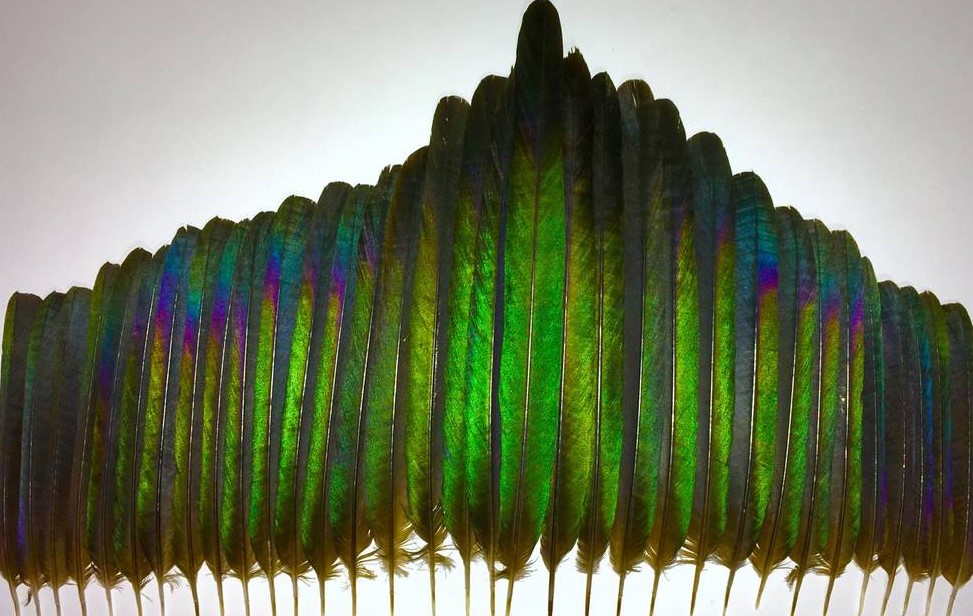Quetzals
by hughpierre
Quetzals are strikingly coloured birds found in forests and humid highlands, that favour the border areas around the whole of the valley of man.
Generally, quetzals have iridescent green or golden-green wing covering the back, chest and head; with a red belly. They are strongly sexually dimorphic, with female plumage tending to possess more earthy colours. Therefore, the feathers being most desired are the two tail feathers of the males of six species of the bird. Even with their famously bright plumage, they can be hard to see in their naturally wooded habitats, making them hard to catch. They also do not last long in captivity and certain variants' feathers are more susceptible to degrading, due to tough handling, than others.
Quetzals, or quetzalli, are also specifically the birds' feathers as being a rare and valuable standard by which merchants, cities and states fall back on when no alternative trade can be reached.
Mechanics & Inner Workings
Symbolic System of Colours
Black for weapons representative of obsidian
Yellow for food representative of corn
Red for war representative of blood
Yellow for food representative of corn
Red for war representative of blood
Blue for sacrifice representative of water
White for death representative of air
Green is the royal colour representative of Serpentism
White for death representative of air
Green is the royal colour representative of Serpentism
Estimated Cacao Conversion Rate
| Single
Quetzalli |
Resplendent | Golden-headed | Pavonine | Crested | White-tipped | Eared |
|---|---|---|---|---|---|---|
| Worth in
cacao beans |
~160 cacao beans | ~140 cacao beans | ~100 cacao beans | ~80 cacao beans | ~40 cacao beans | ~40 cacao beans |
Manufacturing process
Gods and kings frequently wear magnificent feathers as part of elite clothing for dance and war. In the valley, quetzal feathers are notable for appearing blue from some angles and green at others, often with a shimmering golden overlay. Every male quetzal bird has just two of these long, flexible tail feathers (called coverts when still attached), and these elusively solitary birds prefer forested mountains far from the basin. Traders would many times trade for these feathers with catchers who lived near wild quetzals.
Smaller feathers from quetzal wings echo the color scheme, but those are not as prized due to how much smaller and common they are. This has not stopped some from trying to pass off alternative feathers as genuine quetzalli.
Aviaries
There have been many private and public enterprises to breed quetzals for their tail feathers. However, quetzal birds need specific environments in order to survive. Add to that, that the specific male tail feathers used as currency grow out and molt once a year. Therefore, each bird would offer limited return and there is a greater chance that the quetzal would die before even the growing period.Embellisher of Feathers
Deceitfully, there are amantecas of former amantecas who work partly or wholly in counterfeiting quetzal feathers. These "Treaters of feathers" glue and dye old, worn and damaged feathers to resemble the real articles to trade to nobles who could realistically afford them.Significance
In addition to the quetzal, especially precious feathers come from brightly-colored tropical birds such as the bright blue cotinga, dark red of the roseate spoonbill, brown feathers from the squirrel cuckoo, emerald toucanet, gold appliqués, macaw, parrot, hummingbird, oropendula and troupial. However, more common feathers of domesticated ducks and turkeys are also traded for, but they are as quickly taken out of circulation as material for the arts.
It is the same for quetzals, as it is for cocao beans, in that feathers are used as a part of permanent decorations. Feathers are incorporated into clothing and accessories, including headdresses, capes, loincloths, armbands, backracks, shields, banners, and fans. However, while this may be the fate of many lesser bird feathers, it is much rarer for someone, even a rich man, to want to use quetzals in such a way (as to make themselves poorer). Yet, ennobles would collect and show off quetzal works as a sign of prestige status among their own peers.
Item type
Currency & Deeds
Current Location
Manufacturer
Rarity
| Uncommon | Rare | Exquisite |
|---|---|---|
| White-tipped | Pavonine | Resplendent |
| Eared | Crested | Golden-headed |
Dimensions
1 arm long
Raw materials & Components
Levels of Quetzal Denomination:
- Resplendent Quetzal
- green upper tail shines in a variant of iridescence from green-gold to blue-violet
- Golden-headed Quetzal
- uppertail are a darker green that extend beyond the tip with a black undertail
- Pavonine Quetzal
- iridescent green upper tail with a black base and bronze edges
- Crested Quetzal
- metallic green and white on either side
- White-tipped Quetzal
- black upper tail with the tip appearing white
- Eared Quetzal
- iridescent dark blue through the center of the outer tail being terminally white and banded black at the base
Tools
There are many individuals who developed unique bird traps meant to capture wild quetzals.
Related Materials




Comments